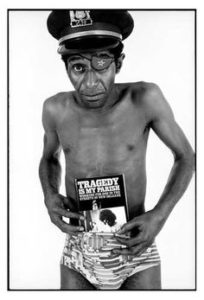IGNORED OBSCURED RESTORED

If you’re a regular reader of the SotW you know that I consume a significant amount of print space exposing my readers to the buried treasures of rock music. I spend a considerable amount of my free time reading books and magazines and listening to music in order to uncover underappreciated artists and acts.
Now and then I’m blown away by someone that I’m unfamiliar with and can’t quite grasp how they eluded my consciousness for so long. That happened to me a few weeks ago when I caught a documentary on Netflix called Bayou Maharajah: The Tragic Genius of James Booker.
As it turns out, Booker was one of the greatest New Orleans style piano players ever to grace our planet. He could play classical (he loved Chopin), jazz, blues, R&B and rock – making it all his own. In MOJO magazine, journalist Jim Scheurich chronicled his diverse talent:
As at home in the church as he was amid New Orleans’ shore-leave Babylon of clubs and bars, the young Booker was also at ease with the classics as he was with R&B and pop. To Booker, it was all grist to the mill of an extraordinary musical mind, freewheeling spirit of playfulness and dazzling digital dexterity.
How in the world did I miss this guy? It just goes to show, “the more you know, the more you know that you don’t know.” (Aristotle)
Booker was a flamboyant character that played with everyone that’s anyone in 50s-70s rock and R&B — Little Richard, Ray Charles, Joe Tex, Aretha Franklin, John Mayall, Dr. John, Ringo Starr, Jerry Garcia, Maria Muldaur, and the Doobie Brothers among others.
Booker even gave piano lessons to a young Harry Connick Jr., as a favor to his district Attorney dad in exchange for legal help he provided.
Booker’s first charted release was the 1960 organ instrumental called “Gonzo.”
Legend has it the song was a favorite of Hunter S. Thompson and was the inspiration for calling his writing style “Gonzo Journalism.” Booker himself picked up the term from the name of the character Felice Orlandi played in the 1960 crime film The Pusher.
The recording that best exhibits Booker’s style is his take on the1930 jazz standard “On the Sunny Side of the Street.”
In the documentary Connick deconstructs the parts that Booker plays to demonstrate how complicated, challenging and creative his version is. An article written by Tim Penn gives this technical description of Booker’s playing style:
In terms of Piano Style, he was classically trained and had an incredible technique, using a lot of filigree decoration in the right hand — not in quite the same ‘ lazy rolling baroque’ N.O. style as Dr. John. However it was his left hand style that sort of set him apart. He used a sort of syncopated stride style a lot — but instead of doing a root note jump to chord, fifth jump, root jump, fifth jump style, he would either:
1) Break the root note octave quite heavily into 2 notes (from the thumb down to the little finger) i.e. ba-doom jump chord ba-doom jump chord — best exemplified on say his version of On the Sunny Side of the Street. A lot of piano players will break the root octaves a bit when doing a stride piano style, mainly out of laziness etc. (it seems to make accuracy a bit easier) — but Booker’s break was really pronounced and heavy.
OR
2) Uses a double bounce on the root and jump chord like so dum-dum (root or fifth) da-da (top chord) dum-dum (root) da-da. (top-chord) (Like doing a stride piano — in a 16ths shuffle rhythm). This style was his real trademark and he used it on his versions of Junco Partner and Goodnight Irene. Of course this style would possibly not transfer very well to a band situation!!
Booker was an unbelievably colorful character. The documentary is filled with anecdotes about how he lost his eye, his bouts with addiction and mental illness, his paranoia, and many others. I don’t want to be a “spoiler” so you have to see the movie for yourself (or research him online).
Sadly, Booker’s life ended at the young age of 43 in 1983. Even his death had an interesting and tragic angle to it. Apparently some unknown person put him in a taxi cab and sent him off to New Orleans’ Charity Hospital. He died, sitting in a wheelchair in the ER, while waiting to be seen.
But don’t let that be the final word. Watch Bayou Maharajah and discover the full story of this obscure genius.
Enjoy… until next week.
